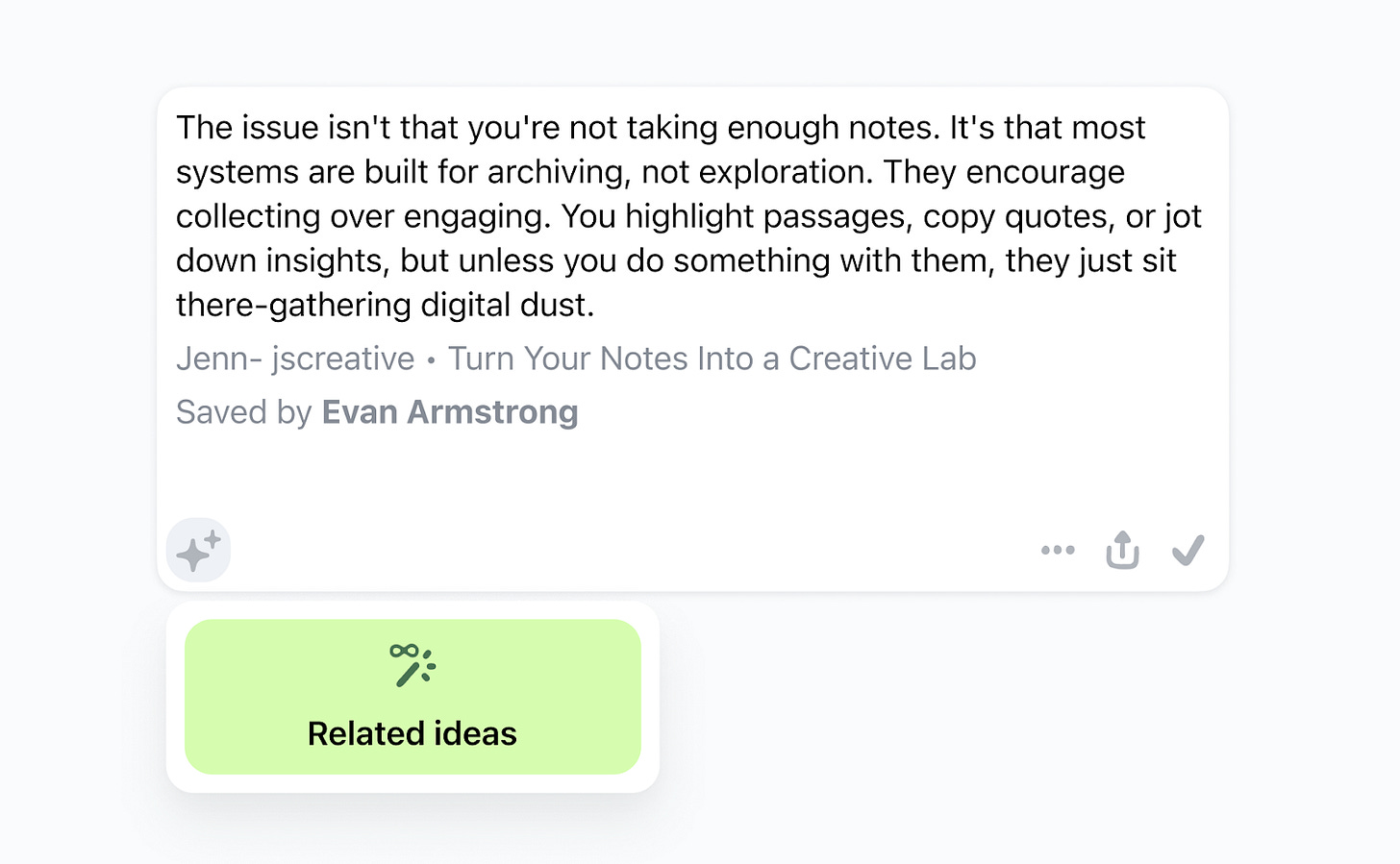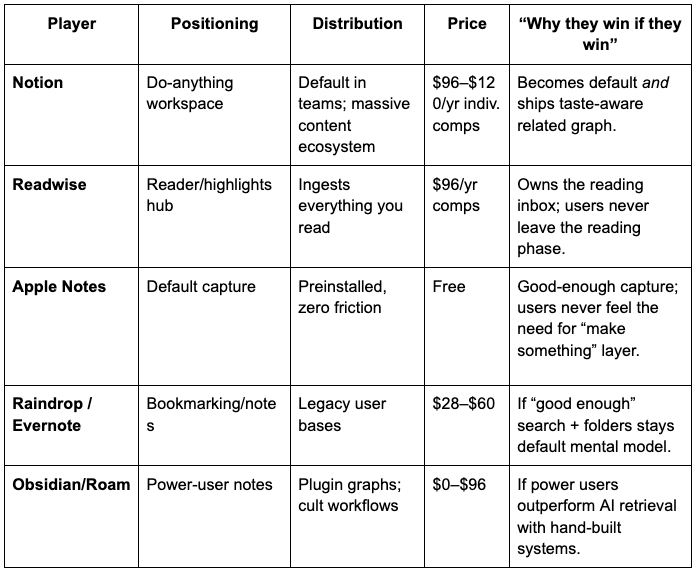Author’s note: This is the latest in my “What’s the Bet” series. AI has the potential to change everything, and founders have to make company-defining choices in response. That is not easy. In this series, companies pay me to analyze their bet and explain it to you. I retain editorial independence. Today’s bet is brought to you by Sublime, a software product with an ethos and product design strategy that is radically different from any other prosumer tool I’ve used. If you have any feedback, about Sublime or this series, just reply to this email.
Sublime’s bet: Notes should do things, not just store things, and AI makes that possible.
I’ve always wanted to be a person who takes notes. The kind who carries a tidy archive of highlights, tags, and cross‑links that future‑me can pluck from on command. In reality, my notes have mostly been polite burial grounds where I file, forget, repeat, and run out of steam for the project in a month or two. Essentially, whenever I have tried to do the whole “have a second brain” thing I got very good at building museums and very bad at making art.
Sublime flips the job of notes. Users drop in an idea, and then fall down a delightful path of related ideas. The value comes from connecting ideas, not merely saving them. Essentially, it means that note-taking is more akin to going on a guided trip through the intellectual wilderness. For example, save a quote about note-taking, and up pops a related tab:
Beneath that I can find essays from Sasha Chapin and Casey Newton, and a highlight from Andy Matuschak. Sublime is betting that it can find interesting related materials that you either wouldn’t be able to locate on your own or that you wouldn’t have time to search for.
The company does this in two ways. First, they’ve built a note-taking system that can easily capture anything from podcast snippets to X bookmarks to Kindle highlights to drop into your knowledge bank. This knowledge bank can then sort and relate those ideas relative to each other—and even cooler—to other notes that users on Sublime have shared. Second, instead of asking a blank‑slate model to impersonate your mind, you can pass all your notes into an LLM. It’s the difference between “write me something about AI agents” and “here are 47 ideas I’ve saved about AI agents, now help me connect them in an interesting way.” The bet is that everyone has access to the same AI. Not everyone has access to your personal library of curated inspiration.
In most tools you search by perfect memory—exact title, exact tag. In Sublime you can search by feel: a half‑remembered line, a mood, the vibe of a piece you once loved. All of this is made possible by embeddings and LLMs. The team told me they called it “vibe search.” So if you look for “nuanced insight on AI agents and whether they work,” two articles of mine are the first result. (This is a sponsored review, but I did not pay them to do that.)
This all lands in a broader shift. For a decade, software sold speed and efficiency. With AI, speed is cheap. What’s scarce now is judgment about what’s worth making, and the taste that shapes it. Sublime’s founder Sari Azout told me that the goal is to move from productivity as an end to creativity as a practice.
Sublime’s bet is that the winning personal knowledge-management tool will be the one that changes the nature of notes rather than be the one that captures them most efficiently.
That’s the bet we’ll test in the rest of this piece: Can a tool that treats notes as creative fuel (not storage) turn every saved idea into a potential starting point for discovery and creation? Personal knowledge management and general productivity is an enormously challenging category for startups, so you have to be incredibly distinct just to survive.
TL;DR (the bet): Sublime bets that the winning “second brain” won’t be the biggest database—it’ll be the one that actually helps you do something with it. If a tool can turn a single saved item into a dozen adjacent, high‑quality ideas and pipe your curated context into LLMs, users will pay for it and stick with it.
A web of gambles
As long time readers know, I like to think of companies as a bundle of related bets. Sublime is betting its existence on three things:
Communal knowledge management: A multiplayer knowledge graph beats private note silos on discovery, and returns more ideas per note.
Taste unlock: Users will pay for software that injects their own tastes into LLMs, turning generic AI into differentiated output.
AI‑first search: As embeddings get cheap, “vibe/meaning search” replaces tags/folders for creative retrieval.
The reason you should think of companies as a portfolio of bets, versus three individual wagers, is that the gambles are what creates the positioning. Sublime’s bets around AI technical architecture and knowledge management show that they are trying to sit in a sometimes uncomfortable middle ground—one where users want to feel creative and want to use AI. This stands in contrast with the many, many competitors in the space.
Are these bets paying off?
So far, yes. Sublime has raised $2 million, but the founder was reluctant to talk about that, telling me, “the magic in business is making money, not raising money.” Instead, she held up the quality of her customers as proof, ranging from Hubspot co-founder Dharmesh Shah, Twitter co-founder Ev Williams, and Pixar legend Ed Catmull. It has mostly grown through word of mouth, and a Substack with 50,000 subscribers, written by the team.
This capital has built Sublime a robust product suite and a product that is beloved with one of the highest retention rates I’ve ever seen in prosumer tooling. The company only sells annual subscriptions, and first year renewal rates average at 79%. This is exceptionally high.
They’ve built the product and engaged a passionate fanbase that isn’t going anywhere. Now they need to figure out how to scalably acquire high-quality customers who don’t care about personal knowledge management. As the table above demonstrates, there are many challengers that have targeted the note fanatics among us. The key to these companies’ success will be whether they can generate demand among people who don’t know what personal knowledge management even is. They are attempting sponsorships with extremely handsome newsletter writers to fix that, but results are still TBD.
The company’s other growth efforts include shipping on-ramps like Podcast Magic that pull people into the deeper Sublime tool ecosystem, with strong paywalls at the “make something” moment.
Why this could be huge
The company benefits from two primary market tailwinds.
Technical stack is getting crazy cheap and crazy powerful: Embeddings got 5–50× cheaper in 2024, making semantic/vibe retrieval financially trivial per save.
Culture is moving from productivity to creativity: I think there will likely be a pushback against AI slop by some members of the populace. AI makes content cheaper to create, but users will need new tools to help them build a sense of taste, of knowing what to create. Sublime has a chance of being that. Add in the multiplayer aspect of Sublime, and there can be light network effects that allow people a curated place free from the broader noise of the internet.
ChatGPT can’t be everything. There will be lots of space for curated, creative spaces for people to use.Then once customers are in, it’ll be difficult for them to churn because the file architecture is so different from other note tools. By owning the taste graph (curated cards + notes + collections) Sublime compounds and powers better related results which is hard for other tools to replace.
The simple promise
Most note tools are filing cabinets. Sublime is a studio. Save a line and it answers with adjacent sparks; pull your references together into a collection, and with a single click, Sublime pipes your own references into ChatGPT or Claude so you can start creating from your own ideas.
If you’re curious, try Sublime. In personal experience, saving an excerpt from an article I wrote and discovering a line from Julia Cameron’s The Artist’s Way was indeed, a sublime experience.







Nice. I wrote something about the incredible Sari when Sublime was called Startupy: https://www.whitenoise.email/p/startupy
“Imagine if Reddit, Wikipedia, the Social Science Research Network, ResearchGate, and Twitter had a more sartorially-elegant, sophisticated, insightful child. In this particular case, the sum far exceeds its constituent parts.
Just as Figma makes design both collaborative and communal, so too does Startupy knowledge work, research, and intellectual inquiry. It turns what is all too often a single-player game into a multi-player one.
It takes what curious curators and link hoarders once relegated to cluttered bookmarks or folders and brings these resources out into the open. Once there, a frenetic hubbub of passionate nerds delve ever more deeply into their chosen areas of interest, passion, and expertise, making public, networked connections and associations all the while
It embodies James Clear's advice: “Do interesting things. Share them publicly."”
Thanks, Evan. I'm curious to hear how you think this relates to Claude, ChatGPT and everything using connectors to integrate with Notion and other PKM-apps. This could kind of take care of the vibe based search and creativity aspect that Sublime is betting on.